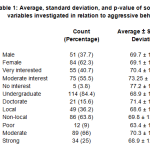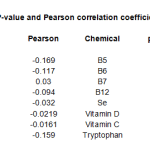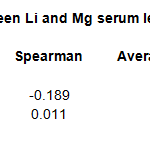Seyed Ahmad Hosseini1*, Masih Namjounia2, Ziba Ghorbanverdi2, Farahnaz Amirlou3, Mohammad Aberoumand4, Mohammad Hossein Haghighizadeh5
1Nutrition and Metabolic Diseases Research Center, Ahvaz Jundishapur University of Medical Sciences, Ahvaz, Iran. 2Nutrition Science, Ahvaz Jundishapur University of Medical Sciences, Ahvaz, Iran. 3Clinical Psychology, University of Social Welfare and Rehabilitation Sciences, Tehran, Iran. 4Biochemistry, Faculty of Medicine, Ahvaz Jundishapur University of Medical Sciences, Ahvaz, Iran. 5Statistics and Epidemiology, Faculty of Health, Ahvaz Jundishapur University of Medical Sciences, Ahvaz, Iran. *Corresponding author E-mail: seyedahmadhosseini@yahoo.com
Abstract
Thus far, limited investigations have been conducted on the relationship between nutrition and aggressive behavior. The current study aims at determining the correlation between food intake and also the serum level of lithium and magnesium with aggressiveness in selected dormitory students. This analytical-interim investigation was performed on 135 male and female students. The sampling method was random and aggression questionnaire was used to evaluate the level of aggressiveness. Moreover, 5 cc fasting blood samples were taken from these volunteers and the serum lithium and magnesium levels were determined. In order to analyze the food frequency questionnaire, we used IVNutritionist and for the rest of the data SPSS was used. Demographic description of thesamples was conducted by descriptive statistics including average, percentage, and standard deviation. The Chi-Square test was used to analyze the data and the Pearson/Spearman correlation coefficients were employed to analyze the qualitative variables. Finally, student’s t-test was used to analyze thequantitative variables. The significance level was assumed to be P < 0.05. Results from the food frequency questionnaireindicates that among the micronutrients, calcium, iron, and tryptophan have a meaningful inverse relation with aggressiveness. Experimental results confirm the absence of any meaningful relationship between the serum magnesium level and aggressiveness. Nevertheless, there exists a meaningful inverse relation between the serum lithium level and aggressiveness. The aggressiveness does not correlate with serum magnesium level while it correlates inversely with lithium.Furthermore, calcium, iron and tryptophan have inverse relation to aggressiveness.
Keywords
Aggression; lithium; magnesium
Download this article as:| Copy the following to cite this article: Hosseini S. A, Namjounia M, Ghorbanverdi Z, Amirlou F, Aberoumand M, Haghighizadeh M. H. Food Intake Assessment, Measurement of Lithium and Magnesium Serum Levels, and Their Correlation with Aggression in the Residents of Ahvaz Jundishapur University of Medical Sciences’ Dorms in 2012. Biomed Pharmacol J 2015;8(March Spl Edition) |
| Copy the following to cite this URL: Hosseini S. A, Namjounia M, Ghorbanverdi Z, Amirlou F, Aberoumand M, Haghighizadeh M. H. Food Intake Assessment, Measurement of Lithium and Magnesium Serum Levels, and Their Correlation with Aggression in the Residents of Ahvaz Jundishapur University of Medical Sciences’ Dorms in 2012. Biomed Pharmacol J 2015;8(March Spl Edition). Available from: http://biomedpharmajournal.org/?p=2338> |
Introduction
Psychologists define any hostile or violent behavior or attitude toward someone else as aggression1. In order to control such a behavior the aggressive person has to admit that their behavior may harm someone else1. Aggressive behavior is identifiable through fidgetiness, irritability and susceptibility to becoming hostile or violent2.Two factors have been considerably taken into account regarding aggressive behavior. First, such a behavior has increased in worldwide societies. Second, it is mostly observed in adolescents3. In the last three decades, it has been shown that dietary choices affect the behavior4.The correlation between nutrition and behavior is based on basic potential mechanisms6. In addition to that, during the recent years, signs have been traced regarding the relation between the nutritional diet and aggressive behavior5. Epidemiologic research has confirmed a profound alteration in nutritional diets especially in developed countries8. Some ecologic investigations also indicate correlation between the diet and behavior, including aggressiveness9, 10.Nutritional factors affecting aggressive behavior are classified as vitamins, minerals and amino acids.Vitamin B-group vitamins and more importantly vitamin C could give rise to fidgetiness which may lead to aggressive behavior in different people6-10.Some minerals contributing to aggressive behavior include lithium, magnesium, manganese and iron13, 18, 21, 24. Moreover, the amino acid tryptophan, as one of the essential amino acids,is the precursor to serotonin and plays an important role in exhibiting aggressive behavior35. Since there was no study on this topic in Iran, we decided to perform current investigation.
Methods
The current analytical-interim investigation was performed on the male and female students living in Ahvaz Jundishapur University of Medical Sciences dorms.Sampling was performed randomly and 135 students were chosen among those who qualified for the entrance requirements dictated by the investigation. Preceding requirements included not being diagnosed with depression and other psychotic problems, not suffering from cardiovascular, liver, or kidney diseases, and finally, not using dietary supplements. The criteria for being omitted from the study was not filling the consent form or not responding to all the questions. Prior endorsement by the psychology committee at the office of the vice president for research was obtained and conscious consent was taken from the students before participation in the study after elaboration on the goals and methods of the study. Moreover, in order to increase the trust and confidence in the students, the questionnaires were anonymous.Three questionnaire forms were employed to collect the data. The first questionnaire was about demographic information including gender, age, educational level, the amount of interest in their field of study, and other factors affecting the general health and socio economic status. The second questionnaire was Buss-Perry aggression questionnaire which is a self-report inventory and includes 29 items returning scores for 4 dimensions of aggression, i.e., physical aggression, verbal aggression, anger, and hostility. Participants rank preceding statements along a 5 point continuum from “extremely uncharacteristic of me = 1” to “extremely characteristic of me = 5”. The highest and lowest scores are 145 and 29, respectively. Persian stability and justifiability of the former questionnaire has been approved in assessing aggression4. The last questionnaire was the food frequency questionnaire (FFQ) which contains 53 items including cereals, vegetables, meat, fruits, dairy products and nuts which was designed based on the foods provided in the dormitories and the food consumption of each student was monitored over a year.Once the participants filled all the questionnaires, after getting their written consent, 5 cc fasting blood samples were taken from them which were then sent to the laboratory for measuring lithium and magnesium serum levels.The FFQ was analyzed using IV Nutritionist and SPSS (version 16) was employed for the analysis of the rest of data. Demographic description of the samples was conducted by descriptive statistics including average, percentage, and standard deviation. The Chi-Square test was also used to analyze the data and the Pearson/Spearman correlation coefficients were employed to analyze the qualitative variables. Finally, Student’s t-test was used to analyze quantitative variables. The significance level was assumed to be P < 0.05.
Results
160 questionnaires were distributed among the male and female students living in the dormitories of Ahvaz Jundishapur University of Medical Sciences and finally, 135 fully filled-out forms were collected which were subsequently used for the current study. 51 participants were males (37.7 %) while 84 were females (62.3 %). Further, 114 participants (84.4 %) were undergraduate students and 21 (15.6 %) were doctoral students. Local provincial students made 36.2 % (49 students) of the studied community while 63.8 % (86 people) were non-locals. The results of the current study imply that aggressive behavior has no correlation with gender, origin, education level, and family’s monthly income (Table 1).
 |
Table 1: Average, standard deviation, and p-value of some of the
variables investigated in relation to aggressive behavior |
Besides, the results based on the analysis of FFQ forms indicate that among the micro nutrients, only calcium (p = 0.049), iron (p = 0.007) and tryptophan (p = 0.046) have a significant inverse relation with aggressive behavior (Table 2).
 |
Table 2: P-value and Pearson correlation coefficient for the studied variables |
Moreover, the experimental results indicate the absence of a significant correlation between the magnesium serum level and aggressiveness (p = 0.89), while lithium serum level and aggressiveness have a significant inverse relation (p = 0.029) (Table 3).
 |
Table 3: Correlation between Li and Mg serum level and aggressiveness |
Discussion
Psychologists, define any hostile or violent behavior or attitude toward someone else as aggression1.In order to control such a behavior the aggressive person has to admit that their behavior may harm someone else1. Aggressive behavior is identifiable through fidgetiness, irritability and susceptibility to becoming hostile or violent2. The correlation between nutrition and behavior is based on basic potential mechanisms6. In addition to that, during the recent years, signs have been traced regarding the relation between the nutritional diet and aggressive behavior5. Nutritional factors affecting aggressive behavior are classified as vitamins, minerals and amino acids. Some minerals contributing to aggressive behavior include lithium, magnesium, manganese and iron13, 18, 21, 24. Lithium is a monovalent element which is used in bipolar disorder treatment. On the other hand, magnesium deficiency is correlated with behavioral variations. The current study is the first investigation conducted so as to find out the relation between the diet and aggressiveness.Findings based on this study, which was aimed at food intake assessment, measurement of lithium and magnesium levels in serum, and their correlation with aggression in dormitory students, showed that aggressive behavior in the students had no significant relation to the magnesium serum level while it has an inverse relation with lithium serum level. Moreover, calcium, iron and tryptophan had an inverse correlation with aggressiveness. These results were consistent with some other investigations. For instance, Kapusta and co workers (2009) conducted a study on 6460 Austrian citizens in order to assess the relation between lithium level and aggressive behavior and arrived at the same results11. Besides, a similar study was done by Ohgami and coworkers in 2006 in Japan12. In an investigation by Raleigh on animals it was determined that tryptophan and aggressiveness are correlated which is in line with our current results15. Findings based on the research by Rosen are also indicative of a significant relation between iron and aggressiveness.
In contrast, our results were not consistent with some other investigations, including the lack of a significant relation between magnesium and aggressiveness, according to Kantak14.
Current study confirmed that aggressiveness in students has no significant relation to magnesium serum level, while there is an inverse relation between lithium and such behavior. Furthermore, calcium, iron and tryptophan had an inverse correlation with aggressiveness.
References
- Anderson, C.A., & Bushman, B.J., Human Aggression. J Annu Rev Psychol. 53: 27 (2002). .
- Fielder, S., McNamara, J. R., The Prevention of Child and Adolescent Violence: A Review, J Aggress Violent Beh. 8: 961 (2003).
- Gottschalk, L. A., Rebello, T., Buchsbaum, M. S., Tucker, H. G., & Hodges, E. L., . Abnormalities in hair trace elements as indicators of aberrant behavior. Compr Psychiat. 32(3): 229 (1991).
- Buss, A., Perry, M., The Aggression Questionnaire. J PersSoc Psychol. 63: 452 (1992).
- Hibblen J.R., Ferguson T.A., Blasbalg T.L., Omega-3 fatty aciddeficiencies in neurodevelopment, aggression and autonomicdys regulation: Opportunities for intervention. Int Rev Psychiatr. 18: 107 (2006)..
- Cordain, L., Boyd Eaton, S., Sebastian, A., Mann, N., Lindeberg,S.,Watkins, B.A., O’’Keefe, J.H., Brand-Miller, J., Origins andevolution of the Western diet: Health implications for the 21stcentury. Am J ClinNutr. 81: 341 (2005).
- Sandstead, H., Frederickson, C., Penland, J., History of zinc asrelated to brain function. J Nutr. 130: 496S (2000).
- Muskiet, F.A.J., Evolution air egeneeskunde. U bent wat u eet, maar u moetweerwordenwat u. Ned Tijdschr Klin Chem Labgeneesk, 30: 163 (2005).
- Peet, M., International variations in the outcome of schizophreniaand the prevalence of depression in relation to nationaldietary practices: An ecological analysis. Br J Psychiat. 184: 404 (2004).
- Hibbeln, J.R., Davis, J.M., Steer, C., Emmett, P., Rogers, I., Williams, C.,Golding, J. Maternal seafood consumption in pregnancyand neurodevelopmental outcomes in childhood (ALSPACstudy): An observational cohort study. Lancet, 369: 578 (2007).
- Kapusta, N.D., Mossaheb, N., Etzersdorfer, E., Hlavin, G., Thau, K., Willeit, M., Praschak-Rieder, N., Sonneck, G., Leithner-Dziubas, K., Lithium in drinking water and suicide mortality,Br J Psychiatry, 198: 346 (2011).
- Ohgami, H., Terao, T., Shiotsuki, I., Ishii, N., Iwata, N., (2009),Br J Psychiatry, 194, pp.464.
- Kantak, K.M., Magnesium deficiency alters aggressive behavior and catecholamine function. Behav Neurosci., 102(2): pp304 (1988).
- Raleigh, M.J., McGuire, M.T., Bidirectional Relationships Between Tryptophan and Social Behavior in Vervet Monkeys. AdvExp Med Biol., 294: 289 (1991).







